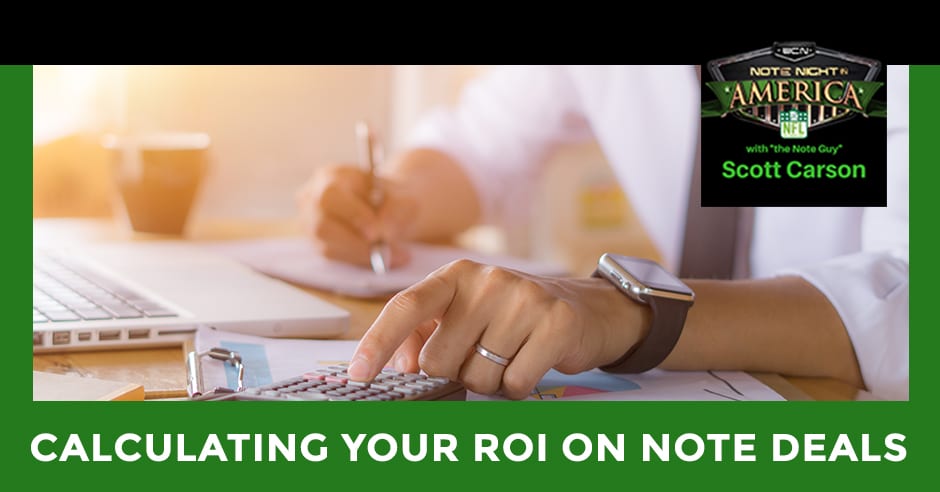
In tshis episode of Note Night in America, Scott Carson breaks down the simple and easy ways to calculate your expected return on investment (ROI) on your note deal depending on the strategy and why it’s important to know the most profitable strategy. He discusses how to calculate the ROI on a reinstatement (trial payment plan or loan modification), foreclosure (deed in lieu of foreclosure and/or cash for keys), and the return on investment if you kept the property as a rental property. He also shares the simple ways to calculate a note sale and the profits from selling your seasoned performing note to a note investor looking for a passive return.
While you are here, you can get 20% off of your lifetime access by signing up at http://NoteProz.com and using the code WCN20%.
—
Watch the episode here
Listen to the podcast here
Calculating Your ROI On Note Deals
We’ve got a lot of stuff to cover. I’ve got some things for you to dive into and take a look at. For some of you, to be able to walk with some things as well here for you. Anyway, up-front ROI due diligence. We’ll be diving into that information. For those that are joining us for the first time, welcome. I want to dive into the content. Once again, thank you for being one of our million-plus readers. We’re excited to have you be a part of this. I do get questions all the time from people like, “Scott, we see a spreadsheet. Do you have a master spreadsheet with all your formulas in it?” I’m like, “No, I don’t,” because every spreadsheet is different. Every seller, a lot of times, every lender will have different information in different columns. There’s not a master spreadsheet that I can give you that you can dump everything in because once you start copying and pasting things and we all know what’s going to happen with that. It’s going to be all sorts of messed up and broken and not work well for you.
The big thing I wanted to go through with you is that formula process. I’ve taken the time to outline basic formulas here that once you’ve got it, now you can take this and put this on the wall, keep it in your folder or keep it somewhere where you can access it. As you start getting in tapes, you can start running these columns or running these formulas in your columns so that stuff runs for you. When I was traveling a lot, my staff was here in Austin. I would give you these formulas and they could go through and based on some basic information, we’re talking upfront ROI due diligence. We’re not talking backend. That’s what I want to make a big caveat about for this. I could give my staff a list of 500, 600 notes and they would run these numbers, run these formulas in the spreadsheet.
It would help them identify the best assets and they can literally bid on these assets for me without me doing any work. Many of you are spending hours on individual assets. You don’t know everything. You’re still going to have to pull value. You’re still going to have to double-check a lot of things, but there’s not a lot of reasons to waste a lot of time doing every little bit of due diligence and then not making bids. I hate to say this, but a lot of you suffer over from analysis paralysis where you’re over-analyzing, trying to figure every little cost in there. It’s not the case because you don’t know which way the wind is going to blow. A lot of you are driving yourselves mad and crazy, pulling your hair out, trying to figure out where everything is at and you have to take a step back and go from there.
When I look at a spreadsheet, especially when you’re dealing with a nonperforming side, this is exclusively for nonperforming notes. Performing notes, you pay what it is. You take your payments, divide them by what you’re paying for the note. That’s your ROI. It’s easy to figure out. As a nonperforming note investor, we know the exit strategy can go a variety of ways, whether it gets them reperforming, it becomes deed in lieu, Cash for Keys to walk, or we’ve got to go the legal route and foreclose. You’ve got to figure out what happens if I sell the asset? Do I want to keep it? Do I want to sell it? Do I want to sell it as an REO? Do I want to take the property back and add it to my portfolio?
My answer is it still depends on a lot of things that’s going on, but what we are covering with you is the idea to help you out there. Most of our strategies, yes, buying of the notes, the reperforming, the modifications, the foreclosures, the deed in lieu, Cash for Keys, short payout, all that often falls into 1 of 3 basic strategies that you can figure in with a formula and adjust depending on the timeframe for it. The basic thing is one, retain for cashflow. By this, whenever you get the note reinstated, the borrower starts to make payments or you start putting them on a trial payment plan and then you go to a permanent modification.
Take The Property Back
Remember, never go to a modification straight out of the gate. Always do a trial payment plan for at least twelve months and then go to a permanent modification. Who knows what’s going to happen with the tax laws and short-term and long-term capital gains? It could vary. As it sits, if you modify a loan, you’re going to be taxed on the full UPB even if you modify it. We don’t want that with a TPP, a twelve months trial payment plan. That turns into long-term capital gains versus a short-term capital gain. Something that’s important. The second thing is to take the property back, deed in lieu, Cash for Keys or foreclosure, and then sell it. Sell it as an REO, whether it’s selling it at the auction or selling it after it’s sold on the MLS.
Keep It As A Rental
The third strategy is what do you do if you don’t sell it, do you want to keep it and take it back as a rental? We’re going to cover a couple of bonus things in there. What happens on a note sale? How do you calculate that? For the most part, we’re going to cover these three main things. I am a big advocate. Here’s the thing. I am not one of these people that details every little closing costs or every little possible thing on my ROI calculator. That’s mind-numbing. I don’t even get into that when I have all that information because we all know that deals can go both ways. What I’m a bigger advocate of is let’s say let’s lump some basic costs in, some neutral costs that can go the foreclosure route.

Calculating Your ROI: If there’s an occupancy, the property must be occupied because ghosts don’t pay.
Retained Cash Flow
They can go a couple of other ways for you out there so that you can figure those costs in and be ready to rock and roll for you. The first strategy is retain for cashflow. “I’m buying it out. You’re in the note business, you’re retaining for cashflow.” Can we agree to that? Yes, we can. Usually, this is going to be your highest return on investment. If the numbers you run come out to a low ROI, it’s probably best to kill the deal. Why? The low ROI on a loan mod, I’ve seen people get burned where they’re like, “This is going to be an REO.” For sure. They bought it as an REO and lo and behold, the borrower showed up with money and reinstate the loan and was able to pay it back.
They got stuck now buying a nonperforming loan they bought that yield probably at 6%. They tied up $250,000, if not more, if I remember correctly, on a New Jersey note that I was like, “Don’t buy because if it does turn into a reperforming note and they do modify, it’s a low yield based on what you’re paying.” You don’t want to tie up a chunk of money that’s not paying you hardly anything. If you’re happy with that and it’s your own money, that’s fine. This is my qualifying number. This number usually has got to be somewhere between 20% and 30% when we run our numbers on the nonperforming side of it. Any below 25%, 30%, if you’re using Other People’s Money, OPM, you probably want to. If you’re using your own funds and it falls like at 12%, 15% and you’re happy with that, by all means, it’s totally fine. It’s easy.
Some of the things you’ve got to keep in mind when you’re looking at your spreadsheet, if there’s an occupancy, the property must be occupied because ghosts don’t pay. If it’s a vacant asset it’s not going to be a reperformer. I talked to a couple of people, they’re like, “We’re going to modify these.” I’m like, “How are you going to modify them if you see that legal’s already done and a foreclosure auction is scheduled tentatively?” That’s not going to be a loan mod. That’s going to be more of an REO side of things. I don’t mind looking at it and seeing if there are no twelve months of payments if there was a banking institution. If the borrower has expressed some interest in staying. By that, they’ve made payments along the way of some sort, they’ve made something over the last 12 or 24 months.
They’re not expressing payments, but they’ve also gone ahead and done a couple of other things that are cool like sending in a hardship letter that they want to stay in the home. Maybe they’re not staying at home, but they’ve submitted their hardship payments or they send their package to the loan mod and has been sold a couple of times. There have been a couple of things. A couple of times we’ve bought stuff that there was this huge packet. I’m like, “This borrow definitely wants to do a loan mod,” when the seller had started to go into the foreclosure process. I don’t mind sometimes with that, but it’s got to be occupied.
The borrower’s got to express some interest in staying in the home. Either reinstating the loan, starting over with the existing payments or they’ve got some paperwork already filed there for you. If the legal has been started and we’ve already seen a foreclosure scheduled, then it’s not going to be a loan mod. It’s definitely going to be REO. Don’t bother running through this strategy. If your main strategy is you want to buy notes to get them reperforming, this is one of the biggest things for you. It’s easy to calculate and do your spreadsheet, it’s easy to run a couple of formulas down and go from there. The easiest thing I like to do is taking my P&I payment, make principal and interest payments, or if there is a modified payment in there that’s either higher or lesser than what their payment was, I’ll take that times twelve months and divide that by my purchase price plus costs.
What’s my cost? The purchase price is going to be my servicing costs and taxes for the most part. In the formula there, this is what I have set up for you. If you take P&I times twelve, divide that whatever my purchase price is. If the seller doesn’t give you a selling price, then I try to figure let’s go stair-step method. Anything over $50,000, it’s 55%. If it’s in the $40,000, it’s 45% of either the lesser of UPB or value. If it’s below $40,000 or in the $30,000, it’s 35%. If it’s below $30,000 value, it’s 25% max. If they give us a purchase price, I’m going to figure in at least $1,500 in servicing costs.

Calculating Your ROI: A vacant asset is not going to be a real performer.
You’re going to figure in for nonperforming to be paid for a few months, you’re going to have at least $90 a month. There are going to be some recording fees. If they get them to reinstate their startup, that’s going to be some costs, ala carte fee, the servicing fee. Also, if taxes have to be paid. If they’re barely behind in taxes, I’m not going to pay the taxes because it should be something that’s paid by the borrower. If I’ve got to pay taxes to avoid a tax foreclosure, that’s when I went to calculate in there. P&I times twelve divided by your purchase price and initial servicing costs. If a purchase price from roughly $15,000 and then taxes. That number will give you roughly what your quick fix reinstate model ROI.
What will I do? If they give me a percentage on the column by the value or the UPB, I’ll run my numbers all the way down. I’ll do a column, twelve months P&I times twelve and run that column for twelve months cashflow. What I have is my percentage. I’ll figure in, I’ll run a column for servicing costs and then I can go purchase price plus servicing costs and add that column. That way, I can outline my cost. I may have 4 or 5 insert columns. One more, I run that formula. This column divided by this column equals that. I want this to roughly be somewhere around 20% to 30% on the front-end side. If the borrower reinstates where the first phone call or first letter campaign or stuff like that, that’s a beautiful thing.
You may have less than servicing costs along the way. On the front-end side, I know I’m going to have some servicing costs, boarding and stuff to figure out. Some initial costs for due diligence on that stuff, but that’s the rough upfront cost. That’s going to be the first number I run down and I want to see somewhere 20% to 30% lease. If I’m using some of these other people’s money and they’re going to be 10% to 12%, I want to make sure that I’m at least doubling that somewhere around 25% to 30% on the front-end side. That’s where I want to be. The purchase price, SRV, servicing and a hashtag is taxes. If taxes are avoid a tax sale. That’s the number one formula I’m running down.
What happens if they won’t play ball with you? What if they want to drop the payment down quite a bit below? Here’s the thing, if they’re behind by a year, I’m going to compare what that principal and interest payment is compared to rent. Market rent is always going to be higher. I rarely will drop my payment down. I’ll budge on the back payments, but you get the PITI, principal and interest, which is what I’m going to see the taxes and escrow, that may not be escrow to me or taxes interest may not be escrow. They’ve still got to pay those. It doesn’t make sense for me to be paying a tax bill. I might as well work to do a deed in lieu, Cash for Keys and move on. The next formula is what’s going to happen to take the property back? Here’s the thing. There are three things. Foreclosure. You’ve got to go the legal route or you can do a deed in lieu of foreclosure or Cash for Keys.
If somebody needs some cash, give them Cash for Keys. They all fall in the same thing. Cash for Keys is like Cash for Keys to the property for a deed in lieu. Foreclosure, it happens. The big thing that I like to do is I like to get rid of anything it’s over a year to foreclose. That would be your New York or New Jersey. I boot them. I don’t buy a lot there anyway. No offense to anybody out there. With the longer foreclosure state, try to get rid of it. That’s the same thing. I figured this in roughly too if it’s even a short foreclosure state like Texas, Georgia, if I’m buying in those areas. Even Michigan, sometimes it’s faster foreclosure stuff. I calculate it’s probably going to take me at least a year to either take the property back foreclose and then sell it. The most important thing about this deal, if you have a spreadsheet that doesn’t give you values, you’re not going to pay BPO. You’re going to pay rent to go and pull BPO. You need to pull some estimated fair market value. You dropping into Zillow or NoteProz or Trulia.
You have a realtor jump on NAR, RPR and pull a property value there, but you need to know the value of the property to put that in there. I figure in roughly $2,500 to $5,000 and foreclosure costs. If it’s a nonjudicial state, $2,500. If it’s a judicial state with longer foreclosure timeframes, I figure $5,000. I figure in roughly $1,500 in servicing costs. $1,500 servicing costs, maybe less if I get them to reinstate, if I’m going to Cash for Keys. That’s the biggest thing I want you to see. You might need to look at paying your tax to the tax foreclosure, but the important thing is I like to use my foreclosure costs, whatever costs a foreclosure aren’t doing. That’s my budget if I need to do a Cash for Keys or deed in lieu. I never estimate sell on the property 100% value. That’s never going to happen. Anytime you do that, you’re over-exaggerating.
I’m not going off on repairs too. I’m going off as-is or the market value. If it takes a year to foreclose, what can happen in a year? You can have a lot of appreciation and give some appreciation to go up. I agree to that. I’m going off as this. I’m trying to least valuable and I’m going to take the value of whatever I come up with a property line. You may look at Zillow, Trulia and/or Eppraisal, those online things. You jump on something like NoteProz that gives you a high, low in the middle. I’m going to go 90% of what number I finalize. Why 90%? Even if it’s a beautiful property, you’re still going to have probably 10% in Commissions and Closing Costs, CCC. Plus, if I’m going to list it for sale, even at value and I sold it, I’m going to have some closing costs loss that way because I’ve listed the property.

Calculating Your ROI: If you do have money costs, you need to figure out your money costs and take that off as expense.
I am one of these that like to list my assets, my properties at 80%, 85% to get a multiple bid offer to get people to bid the property up and have less concessions that way. I figured out I got my rough value. I’m going to run 90% of fair market value is what my basically sales price net is after 10%. The thing is, I’m always going to run these formulas on a basis that I’m not having any money costs. If you do have money costs, you need to figure out your money costs and take that off as an expense whatever it would cost you at the end of the year. Initially, with these formulas, it’s based on if you’re using your own funds and keep it simple.
My Cash for Keys amount, if I have to use it, usually it’s either my foreclosure costs or $2,500 to $5,000. I’ve gone up beyond that if I need to if there’s a lot of equity or there’s a lot of appreciation from the time that we buy the note to the time that we can do that. If you can pay somebody $2,500 now to have them walk away in a year-long foreclosure state, you bought yourself a year timeframe that can speed up your return on investment by half or two times. I’m always going to assume that it’s going to take a year to foreclose and sell. I talk about it. If it takes it longer to foreclose, you’ve got to drag out two years to do that, to rehab it, sell it. You’ve got to figure that into your ROI basically, but we’re assuming for shits and giggles for a one-year timeframe.
If it is less, if you can get a deed in lieu, if we foreclose faster and sell it as-is at the auction. Kudos. That’s what I like to do. I’d rather sell it to the auction and not have to worry about listing on the stuff. If you can do it in six months, then what you want to do is take your ROI and annualize it, assume that you could flip that money twice in a year if you can do it six months. If it’s longer, then you want to take one of your ROI calculators and divide that by two. If it took you two years to foreclose and then another year to rehab and sell or whatever that number is. If it’s eighteen months, then you divide it by one and a half to figure what’s your ROI. Here’s the strategy. You take your sales price, my sales price is not FMV times 90% minus your investment, which is your purchase price, foreclosure clause plus taxes if you do that and divide that by your investment. That’s basically net gross minus your investment. That’s your net profit divided by your investment that should equal your net profit divided by your investment. That should give you your ROI. It does not include your money costs. If you do have money costs, you’d want to add in your investment, your 12% interest rate or your split, whatever it might be as part of your FC plus taxes or FC plus monthly costs.
The third strategy is if you don’t foreclose. If you don’t deed in lieu or if you do those, but you’re like, “It’s not selling. I probably need to keep it as a rental.” You still need to run this number on the front end, even though you don’t like rentals. I still run this number in my spreadsheets to show that it does make sense not for me to keep it. It makes sense for me to get rid of the asset and double down. Usually this number, this calculation would be technically the third calculation. It’s always used the lowest. It can be the highest. It has been the highest for me before, especially years ago when we were buying a lot of cheap ass and we were buying some nice assets, but cheap for pennies on the dollar. When you know you’re not going to modify versus foreclose, it makes sense with a rent rate would be like $1,200, $1,500 a month and I’m buying like a $30,000 property. At that point, I’m like, “It does make sense to keep it as a rental.” Let’s look at it that way.
For the most part, these days, especially when you start getting above $50,000 in values especially over $100,000, it doesn’t make sense to keep stuff as a rental because we know if the price value goes up the property, the rent ratio, the rent multiplier goes down. Poor people pay more for rent. It is what it is. This is the thing. I don’t usually want to even think about holding on to a property for rental if it’s over $150,000. It doesn’t make sense for me and most of the time when I bought for the asset and then when I can pay to take the property back and then selling it, get my investment back and then employ that capital in a couple of ways.
You’ve got to know what the market rent rate is. This is a website I use. Rentometer. It’s a company from Boston. I’m not going to look at the peak. The beautiful thing about Rentometer is this is going to give you like a speed dial. You can see how the rent rate falls in and also going to give you dots on a map so you can see if you’re on the outskirts of the market. You can click on the links and see how that property across the street that they have listed if it’s right in there. I’m going to go right by smack dab in the middle. I’m not going to go to peak. I’m also not going to go to the lowest.

Calculating Your ROI: It’s going to take a year to foreclose and sell.
Let’s say the rent on the highest is $1,000, but everything else I see around my property is like $900. I’m going to go to the $900 mark to be safe. That doesn’t mean it’s in a better property or it’s a better position. Maybe it’s got some square footage. Could you get the $950? You could. We’re on the front end of the sides. We’re out on the front end of the business. We’re running some quick numbers that can come in and reasonably run these numbers too so that when you do get your bids back and they counter, accept or that you can see how close you are or how far you are from the deal. They can counter back and your numbers are good. Don’t sit here and try to, “I need to take another $2,000 or $500 off.”
Accept it and get the damn thing closed. If the yield is good and you got plenty of the front side, nickel and diming a seller over a $500 tax bill or even $1,000 tax bill, a lot of cases, I don’t want to deal because if I can’t make that up in some fashion, I’m doing something wrong. In my calculation here for rents, I’m only going to assume that I could collect nine months of rent. Why nine months? There are commission costs, there’s a vacancy factor. There’s also going to probably have to put some clean-out costs in there as well. Anything you would collect in rent, I’m going to figure that’s going to go the way of expenses in the first three months and then you hopefully click the next nine, but what’s it going to take you?
Remember, I’m talking about the front end side. It’s going to take you a year to probably either foreclose and get the property back and get it up to a point where it’s in a position to rent. I don’t include appreciation or rehab costs because you don’t know if you can rehab that property, but you need to have these numbers in line to look and see what it is in case when they do get a counter back and still falls in line. I assume one year to foreclose, one year to get ready and have it rented for nine months. Figure out three months of vacancy, your rental commission and costs along the way. I don’t calculate what it would take for me to refinance the property out because of a couple of things.
Foreclosing On A Property
This is the shitty thing, I’m going to throw this out there. I had this happened time and time again. When you foreclose on a property and you try to get a loan to pull cash out of the deal, try to pull 65% or 60% out, the bank doesn’t like doing that a lot of times. They want you to have that property for at least 90 days before they’ll give you any type of loan. Usually, they’re not going to go at 65%, 60% or any of that stuff. They’re not going to use to go at value. They might go at $0.50 on the dollar, but I don’t calculate that in because I don’t know your credit. I don’t know the condition of the property. I don’t know that stuff fully.
The best that I have found over my years of experience is figuring out this way on the front-end side. This does not include money costs. It’s assuming you’re financing the whole project yourself. If you could get a private money loan from a lender, pull some equity out of the deal from a bank, that’s going to throw your ROI to a whole different phase. I’m also not including depreciation and tax benefits in this. We know once you do take a property back, now you can start appreciating. That’s going to vary on your taxes. I’m not calculating that in here right now. I don’t need to go and chase that down the road because I don’t know if it’s going to get there. I don’t need to sit here and over-exaggerate what my exit strategies are going to be.
I want to be simple on my spreadsheet so I can look at it and make my offers. When the numbers come back, then I can start. As I start doing my due diligence, I start re-adjusting things. I’m good to go. If you take a year to foreclose, then you’ve got to rent it for a year, what’s it going to cost? It’s a two-year, you’ve got to take whatever your ROI is divided by two years to analyze the property. Here’s what that looks like. Rent times nine months. Say the rent is $1,500 and a property. $1,500 times 9, it comes down to $13,500. Divide that by my investment purchase price plus foreclosure gross plus taxes. That’ll give me a number.

Calculating Your ROI: If you take a year to foreclose, then you’ve got to rent it for a year.
Divide that number by roughly two years to figure out my annualized return. Let’s say it took you six months to foreclose and take the property back and you rented it out for a year, great. You would divide that number by 1.5. Whatever it took. If you get a deed in lieu immediately from a borrower, then you can turn around and rent it. I’d say sell it because then you can get your cash back and annualize your ROI back a lot faster. Here’s another thing too. If you’re looking to owner finance the property, you can calculate roughly the same thing. A year to foreclose and figure out what your P&I payment would be on the mortgage.
I don’t like doing that because what you’re going to see is a low ROI as well for the most part. Usually, P&I payments are going to be a whole lot less than a rent payment is going to be and your ROI is going to be even less for you. You’ve tied up that in a note that you can’t evict. You’ve got to go to the foreclosure. It’s not smart to do that as well. I always say it’s best if you can’t get the borrower back on track and get them to take the property back to you to foreclose. Don’t try to play around with being a proper manager. You’re in the note business, stay in the note space. Banks are in the rental business. They’re not in the landlord space. They don’t want to be in it. They want to be lien lords, not landlords. The same thing should go for you guys and gals out there too.
Selling The Note
Here’s some bonus stuff I threw in there. What about selling the note? What can you sell your note for? How do you calculate that real fast? Let me do this for you. Here’s the thing. You need to have some seasoning. You hear me talk about seasoning many times. The borrower’s got to pay on time for a while. I don’t care if let’s say they’re a day late on the 30th and they pay the next month. If they get missed one month, but they made a double payment the next month, I still count that as performing, but don’t think about Madison Management if you’re not using them as your servicer. You get three payments in a row from a nonperforming, no matter if they’re still a year behind, they start paying and you work to get back on that right path. They calculate that as a reperforming note and drop your servicing costs from nonperforming to performing, which can save you a lot of money, roughly about $70 saved on a monthly basis.
I take twelve months of on-time payments, always going to have a third-party servicer in there. Here’s the thing. If you want to figure it out. I’m going to take twelve months of payment, divide that by let’s say 85% of the lesser of UPB or fair market value, whichever is less. If they owe $150,000 and the house is worth $100,000, you can’t sell it at $85,000 or $150,000 because the house might not be worth that. You always want to leave the person buying the note from you some equity in there if they have to foreclose, at least get that paid back.
Twelve months of payments, whatever the fixed payment is, here’s another thing too. If you’re in a trial payment plan, let’s say the payment plan is $500 a month, but after twelve months it drops to $450 or $400, you can’t sell future payments on something that’s expiring. If you have to calculate it and it drops to $400 a month after they’ve been paying $500. You have to calculate your note sale on that lower amount. Somebody will say, “I want to sell it the higher payment.” Great. I want Christmas to be every day and COVID to be gone so I can travel more. It doesn’t mean it’s going to happen. Here’s another thing. If you figure that number, with that first one, 12 months divided by 85% of UPB or FMV, that’ll give you a rough percentage. If you were to take a $50,000 note and sell it at $0.85 on the dollar, that’d be $42,500. Let’s say it was a $500 a month P&I payment. $500 times twelve is $6,000.
$6,000 divided by $42,500, it’s about a 14% cash on cash return. That’s not bad. That’s a good return. It’s hard to sell a performing note, especially when you buy a nonperforming and a lower interest rate results in them paying more than what the UPB is. You’re not going to sell the note above the UPB. Let’s say you want to sell it at a 12% cap rate or a 14% cap rate. You would do this. You take the twelve months of P&I divided by your desired ROI, it should equal the sales price. There you go. P&I times 12 divided by 85% of UPB or FMV whichever the lesser amount is. That’ll give you your rough note buyer’s ROI. We’re selling this note roughly at 12%, 11.7% or 14.5%. If you run this number, it’s like 20%. I’m like, “I’m still on that note way too high.” You’re going to go back and calculate. You’d only see that roughly if the interest rate was high. If the interest rate is low, then you need to roll it back a little bit. Say I need to go to 90%. I get away with 90%, 95% and still be a decent ROI to note buyer to make it desirable to an IRA investor or another investor like you and me out there.

Calculating Your ROI: P&I payments are going to be a whole lot less than a rent payment’s going to be, and your ROI is going to be even less.
Calculating For ROI
Let’s talk about how would you calculate your ROI from selling notes. If we get it back on time and they’re paying twelve months. After twelve months, we can sell it at 85%. What’s my profit going to look like? It’s the same thing. You’re going to take your payments that come in. Basically, take your cash in and divide it by your investment. Your net cash in, your payments plus what you sold the note for whatever your profit in the note sale. That’s your cash in divided by your investments. If you’ve got the borrower to bring $5,000 to the table, that would go when your payments, as I always like to say. If you’ve got a money partner and you’re splitting everything, you want to definitely include that. If you’re not splitting, that might be your elbow grease for doing a little bit of work by helping make that happen.
The important thing is if you can’t figure out what your notes sale proceeds are until you figured out what you sell the note for. That last step we talked about is a strategy you’ve got to go through to figure out. Once again, figure twelve months of payments to make it most seasoned. If you’ve got money costs to cover along the way from an investor, this does not include that. You’ve still got to figure that into the cost out there. This is usually going to be your highest ROI back end strategy. Calculate modified on the front side, which should be good. When you calculate the note sale, it’s going to shoot your ROI sale and definitely a rental sale out of the water ridiculously.
Here’s what it is. Your payments, P&I plus twelve months plus note sale profits divided by your investment. If the taxes are owed, you are going to pay the taxes. If they’re not owed, then don’t worry about it. The first price will be servicing plus taxes. This is the idea that it’s a performing note. You don’t have foreclosure costs. You got some servicing costs and some taxes and you’ve got to pay those for tax sale or to avoid tax and stuff like that. Basically, you’re carrying payment. You’re getting payments for twelve months and selling it at 80%, 85% in a year. It would give you a rough ROI. If you figure these columns, some of these you already have, P&I times twelve. That’s one column and get in there that I use it on multiple sales. I got 80%, 95% or 85% of the fair market value is another column I run it there.
The same columns that you’ve included in your foreclosure costs or your servicing costs, your taxes. Those are things that you can pull off. You need to know how to set the formula up. I don’t run an Excel class. If you need some help with Excel, I would go to Lynda.com or the Khan Academy. You can even go down to FedEx office and they’ve often got a laminated Excel spreadsheet formula thing so you can see how to pull it over. If you know what the column titles are, you can do off of these five formulas for you to work with. If you are in our WCN Crew or you’re also in our coaching, you will be getting an email with these five formulas on a PDF for you to use for yourself.
Have those spreadsheets or download it. I finished tweaking those. I realize the last one had the wrong formula in there, but that’s it. Don’t get me wrong. Your upfront due diligence is not meant to be with a magnifying glass. Don’t suffer from analysis paralysis. It’s not smart. It never ends up working out in the back end. You always figure in 80%, 85% to sell what you’re going to net on a note sale or a foreclosure. Sometimes it’s been less. A lot of the time has been more than that for us, but that’s where I figured. I don’t figure 100% because I’m going to always end up being disappointed at 100%.
That’s the problem that a lot of banks run into. This comes from the mortgage broker in me. Whenever I was doing loans, stuff like that, banks always figure out values and cashflow. It never comes in that valuation. It’s always below that in some fashion, the cap rates because there’s a vacancy factor and other things that happen. That’s why I skew my costs to be a little bit more, my income to be a little bit less so that it works in my favor in the long run. It is a quick and dirty aspect. You need to enter those columns and pull a twelve note and know exactly what every column stands for. Labeling your columns and running those numbers down the road will save you a lot of time. Now that you’ve got those in there, you’d say, “Look at these. This is a borrower. These borrowers that they’ve made some payments.”
“Based on what we were buying this note and what the pricing is for, I need to focus on these 20, get rid of these other 60.” “I got 60 in here. What’s the next step? If I have to take them back to REO, out of the 60 that we like, only 12 are desirable. Let’s get rid of these other 40, but these are the top point of focus.” If you enter these in and get rocking and rolling, you could basically be able to make bids on hundreds of assets or a big portfolio of assets in a few minutes or 1 or 2 hours. I think this was one of the things that separate a lot of our high-end coaching students in our mastermind. We go through this. “Don’t sit here and over analyze and look at every little detail.”

Calculating Your ROI: You can’t figure out what your notes sale proceeds are until you figure out what you sell the note for.
If you spend time on your ROI calculator and have everything on the front end, it’s a waste of time and it will be more confusing because then you’re like, “What if?” Give me three columns so I can look it up. Is it going to be good for a mod? Check. Is it going to be profitable and I have to foreclose? Check. Is it profitable? Is it a rental? That’s more of a strategy. Do I want to keep it or I sure want to sell it as an REO? Get that capital in and redeploy and go out and buy two new notes versus having one dragging around as a rental. If you’re buying condos at pennies on the dollars. It makes sense. If you still have to pay, you’re seeing property going for 60% to 70%. When you start getting above that 50% point in paying for assets, it doesn’t make sense to keep things for a rental, especially if it’s a longer foreclosure process besides what it is here in Texas or Georgia or some of the fast foreclosure state.
Quick and dirty for you. That’s what it’s there for. I want to remind you of a couple of things. There are three upcoming events that I want to make you aware of as we get to last several weeks of 2020. Our good buddy Merrill Chandler is having his Get Fundable Bootcamp. The last one for 2020, I’m told. Tickets start at $97. It’s well worth it. Everybody that’s been through it before agrees. It is one of the most powerful things, especially if you’re looking to raise capital, looking to get lines of credit or helping out with the business. If you’ve got a new LLC and you don’t know exactly how to season it to get your bank to get excited about you. This is 1 of the 2 classes that I require. I require them as fundamental things for you to do. I think it’s one of the most important things you do. I don’t get paid for that. Merrill is a good friend and a good buddy. GetFundableBootCamp.com, get signed up. The website shows it all.
We also give you a discount towards our next class, which is our three-day class, which are Note Buying for Dummies Workshop or Virtual Note Buying Workshop. That’s December 11th through the 13th. That’d be the last workshop of the year. That’s the second, a Friday, Saturday, Sunday of December. It’s a good two weeks before Christmas. It’s a good way to learn and tap into it because we should be hearing back on that Tuesday, the following Tuesday where the market’s going to go. Are they going to extend it? Are they going to delay it? Hopefully, we’ll hear it on the 11th, what their plans are to do on the foreclosure and moratorium eviction. This comes with over a 300-page manual and over $1,000 a money.
This is a little bit more costly. This is $599. That includes you plus a spouse or partner. You also get to replay the previous event and some other bonuses, but this one you can get it signed at NoteBuyingForDummies.com. If you go through Note Weekend and use the code Weekend, you’ll knock $99 off of this. You can get it for $500 versus $599. You’ve got to go through Note Weekend first. A great starting point, a great way to learn and get rocking and rolling. If you can’t sit through three days, there it is recorded so you can catch the replays later on.
We have our Virtual Note Buying Workshop. As many people will attest, I call this the biggest bang for the buck in notes because we go through so much information. A full day on finding deals, a full day raising capital and marketing, and then a full day on the exit strategies and putting systems in place for you. Thank you for being here with me. The webinar for my friend is Get Fundable. Merrill Chandler is the credit messiah. He will break down falsehoods that everybody believes about credit and helps you put things in place for your personal and your business credit. It was one of the most amazing things out there. He’s going online for them, but check it out, go to GetFundableBootCamp.com. It’s a great way to learn about what you need to do and how FICO is affected.
Before I took his class, there were probably a dozen, if not twenty things that we all thought were right and wrong about things. There were a lot of mistakes I made early on I didn’t know about. I think anybody that’s been through that will echo that as well. You will not be disappointed and it’s well worth it. Thank you, everybody, for being here. As always, check us out at WeCloseNotes.com. I look forward to hopefully seeing you at our next Note Weekend Workshop. Be safe out there and we’ll see you at the top.
Important Links
- Rentometer
- Lynda.com
- Khan Academy
- WCN Crew – Facebook group
- GetFundableBootCamp.com
- Note Buying for Dummies Workshop
- NoteBuyingForDummies.com
Love the show? Subscribe, rate, review, and share!

